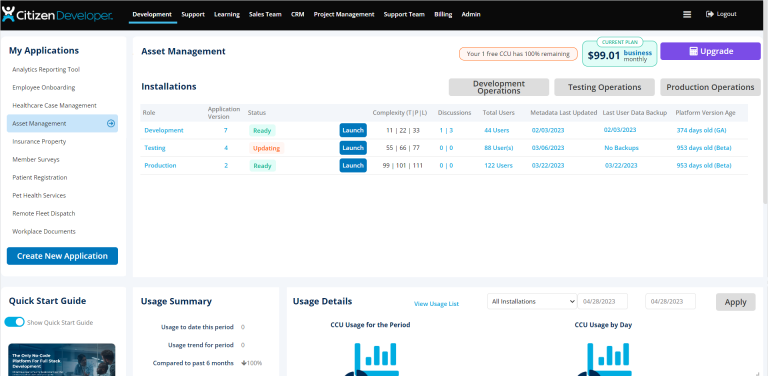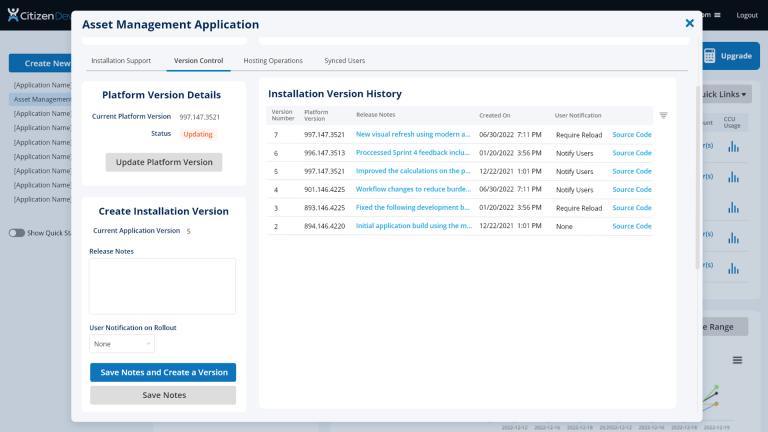Learn Full Stack Development Using CitizenDeveloper No Code
Introduction
Full Stack Development has historically involved years of learning, and even a university education (Good list of University courses). But with the invention of Full Stack No Code Development using CitizenDeveloper.com, one can deploy the same features as with traditional full stack development and in a fraction of the time and cost, but without all of the coding education.
Set Expectations
Don’t set false expectations though. If you need to build a complex real world application, use of a full stack no code tool doesn’t make your task trivial (Why is Software Design So Difficult?). It merely removes the need to learn how to write code. You still need to understand the complications of the underlying data structure you want, the interfaces you need to build to make it actually work in practice, and of course the complex logic.
Again, because this is important; full stack no code only removes the need to write code, it doesn’t remove the complexity of your application needs. This way you and your team can spend your time being creative and designing great experiences and solutions for your users and company.
Start with 2 Key Questions
Before you get started playing around with a full stack no code tool like CitizenDeveloper.com, there are two fundamental questions you need to ask. The first question is “How complicated is your application?” Does it have a complex data layer including many-to-many relationships and redundantly stored data? Does it have complex logic processes? Or is there a much simpler MVP solution you can build to start with?
The second question to ask is “What is your background?” Are you a trained developer? If not, are you familiar with concepts of data layer, presentation layer and logic layer? Have you successfully played with database tools like Microsoft Access? Are you good with spreadsheets?
If your background is non-technical and your application is large or complex, you will likely either need to find a smaller, simpler part of it to start with, or, you may need to ask for help from people trained in translating business requirements into data, presentation and logic layers.
The good news is that the CitizenDeveloper.com full stack no code tools themselves are simple to learn; that won’t be your challenge. The real challenge with full stack no code development remains in translating business requirements. Watch the video below and more Start Developing videos on YouTube.
Develop Just Like a Developer Would (but no code!)
So it’s time to start building your application, but where do you start? Well, we said before that you have to build in 3 layers, data presentation and logic, and in fact it’s best to build in that order! The Citizendeveloper.com tools are arranged to make that easy. So, build in this order:
1. Data Layer
-
Build Tables
-
Build Fields
-
Build Relationships between the Tables
2. Presentation Layer
-
Build Pages
Search Page, Add Page, View and Edit Page
-
Build Containers
On your View and Edit page, setup a new Container to contain the basic details about that record.
-
Build Remaining Fields
On your View and Edit page, build fields for related records. These fields will need to both show the related record, and also manage the relationship between them through a full cycle of add, edit and delete, as desired. If your record has many of the related record, you need to use a list to show all of the related records. Place that list in a content tab below the details area. If your record has only one of the related record, you need a dynamic select field to choose that specific related record. Place that field inside the details area at the top of your view/edit page.
3. Logic Layer
-
Design your Logic
There are no catch-all instructions, you can add logic as needed to fit the needs of your application. CitizenDeveloper does make it easy though to set up.
-
Setup Triggers
Triggers are places where logic is expected to fire from. For example “on click of a button” or “on mouseover of a field”.
-
Setup Schedules
Scheduled Logic is logic that triggers periodically, for example every 5 hours or every day at midnight.
-
Setup Integrations
Use pre-built inbound and outbound integrations or by using REST calls.
-
Setup Functions
Functions are logic that you want to re-run from multiple locations in your applications.
Systems Administration and Dev Ops like the Pros
When you are ready, your platform.citizendeveloper.com account has all the tools you need to manage your large, complex custom application professionally. This includes:
SDLC
Manage your application through a complete cycle of build, test and deploy.

Version Control
Update your application version periodically by saving the development environment. Choose versions to release or rollback to in your testing and production environments.
Also, manage the underlying platform version that you are most comfortable with. CitizenDeveloper releases new features frequently, and those features are contained in platform versions. You control when you update to the latest platform version by performing the update (or rollback) in your platform account.

Complete Suite
There are a range of other important systems administration functions such as managing backups and setting up URLs, all found within platform.citizendeveloper.com. Watch the introduction video below or check out our YouTube channel.
CitizenDeveloper Academy and Online Help
If you get stuck on details, don’t worry, we’ve got you covered. You have a wide range of vehicles to get help. There’s always a community and support team ready to answer any question you may have about how to accomplish something technical or to provide experienced design advice.
Click Help
Click the tool help icon to launch that learning article.
Join Academy
Sign up for Developer Academy training.
Search Articles
Search the help articles and videos available in Academy.
Post a Question
Use the Taxonomy to find the feature you need help with, and post your question. We’ll answer it!
Need Help?
If all else fails, please reach out to us. We want to help you get past your hurdle.
